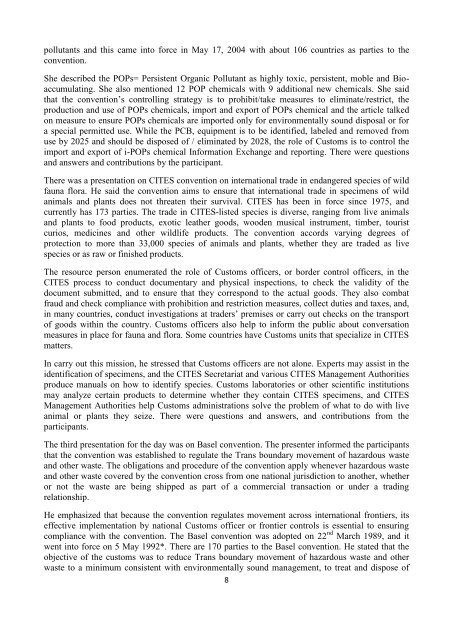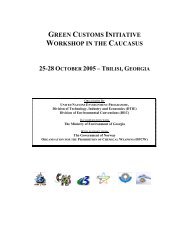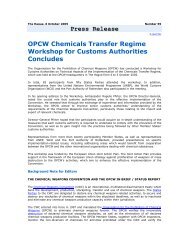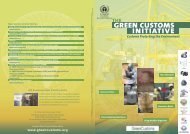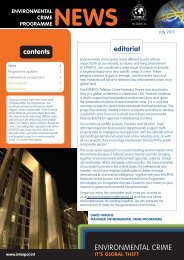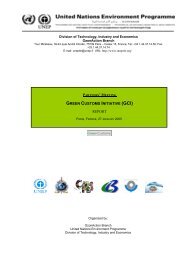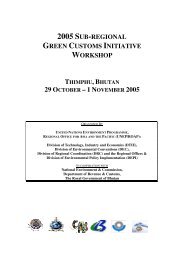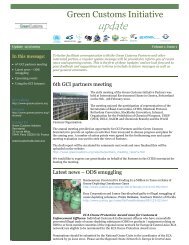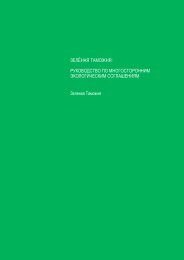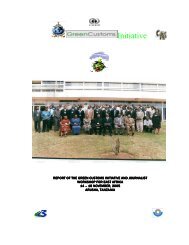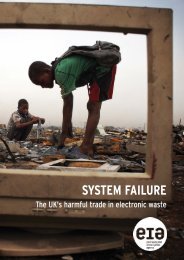workshop report. - Green Customs Initiative
workshop report. - Green Customs Initiative
workshop report. - Green Customs Initiative
Create successful ePaper yourself
Turn your PDF publications into a flip-book with our unique Google optimized e-Paper software.
pollutants and this came into force in May 17, 2004 with about 106 countries as parties to theconvention.She described the POPs= Persistent Organic Pollutant as highly toxic, persistent, moble and Bioaccumulating.She also mentioned 12 POP chemicals with 9 additional new chemicals. She saidthat the convention’s controlling strategy is to prohibit/take measures to eliminate/restrict, theproduction and use of POPs chemicals, import and export of POPs chemical and the article talkedon measure to ensure POPs chemicals are imported only for environmentally sound disposal or fora special permitted use. While the PCB, equipment is to be identified, labeled and removed fromuse by 2025 and should be disposed of / eliminated by 2028, the role of <strong>Customs</strong> is to control theimport and export of i-POPs chemical Information Exchange and <strong>report</strong>ing. There were questionsand answers and contributions by the participant.There was a presentation on CITES convention on international trade in endangered species of wildfauna flora. He said the convention aims to ensure that international trade in specimens of wildanimals and plants does not threaten their survival. CITES has been in force since 1975, andcurrently has 173 parties. The trade in CITES-listed species is diverse, ranging from live animalsand plants to food products, exotic leather goods, wooden musical instrument, timber, touristcurios, medicines and other wildlife products. The convention accords varying degrees ofprotection to more than 33,000 species of animals and plants, whether they are traded as livespecies or as raw or finished products.The resource person enumerated the role of <strong>Customs</strong> officers, or border control officers, in theCITES process to conduct documentary and physical inspections, to check the validity of thedocument submitted, and to ensure that they correspond to the actual goods. They also combatfraud and check compliance with prohibition and restriction measures, collect duties and taxes, and,in many countries, conduct investigations at traders’ premises or carry out checks on the transportof goods within the country. <strong>Customs</strong> officers also help to inform the public about conversationmeasures in place for fauna and flora. Some countries have <strong>Customs</strong> units that specialize in CITESmatters.In carry out this mission, he stressed that <strong>Customs</strong> officers are not alone. Experts may assist in theidentification of specimens, and the CITES Secretariat and various CITES Management Authoritiesproduce manuals on how to identify species. <strong>Customs</strong> laboratories or other scientific institutionsmay analyze certain products to determine whether they contain CITES specimens, and CITESManagement Authorities help <strong>Customs</strong> administrations solve the problem of what to do with liveanimal or plants they seize. There were questions and answers, and contributions from theparticipants.The third presentation for the day was on Basel convention. The presenter informed the participantsthat the convention was established to regulate the Trans boundary movement of hazardous wasteand other waste. The obligations and procedure of the convention apply whenever hazardous wasteand other waste covered by the convention cross from one national jurisdiction to another, whetheror not the waste are being shipped as part of a commercial transaction or under a tradingrelationship.He emphasized that because the convention regulates movement across international frontiers, itseffective implementation by national <strong>Customs</strong> officer or frontier controls is essential to ensuringcompliance with the convention. The Basel convention was adopted on 22 nd March 1989, and itwent into force on 5 May 1992*. There are 170 parties to the Basel convention. He stated that theobjective of the customs was to reduce Trans boundary movement of hazardous waste and otherwaste to a minimum consistent with environmentally sound management, to treat and dispose of8


